
A cherry is the fruit of many plants of the genus Prunus, and is a fleshy drupe.

Prunus is a genus of trees and shrubs, which includes the fruits plums, cherries, peaches, nectarines, apricots, and almonds.
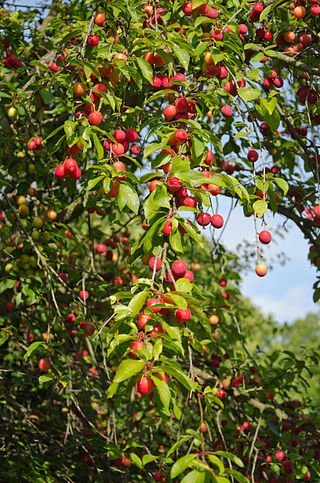
Prunus cerasifera is a species of plum known by the common names cherry plum and myrobalan plum. It is native to Southeast Europe and Western Asia, and is naturalised in the British Isles and scattered locations in North America. Also naturalized in parts of SE Australia where it is considered to be a mildly invasive weed of bushland near urban centers.
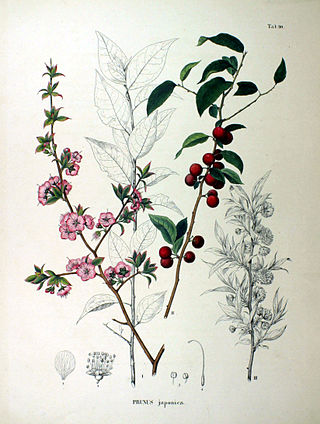
Prunus japonica, also called Japanese bush cherry, Oriental bush cherry, or Korean bush cherry is a shrub species in the genus Prunus that is widely cultivated for ornamental use. Its native range extends from Central China through to the Korean peninsula.

Prunus salicina, commonly called the Japanese plum or Chinese plum, is a small deciduous tree native to China. It is now also grown in fruit orchards in Vietnam, Korea, Japan, Israel, the United States, and Australia.

Prunus maritima, the beach plum, is a species of plum native to the East Coast of the United States. It is a choice wild edible and its few pests and salt tolerance make it a resilient fruit crop for degraded lands and urban soils.

Prunus subcordata, known by the common names Klamath plum, Oregon plum, Pacific plum and Sierra plum, is a member of the genus Prunus, native to the western United States, especially California and Oregon.

Prunus nigra, the Canada plum, Canadian plum, or black plum, is a species of Prunus native to eastern North America.

Prunus americana, commonly called the American plum, wild plum, or Marshall's large yellow sweet plum, is a species of Prunus native to North America from Saskatchewan and Idaho south to New Mexico and east to Québec, Maine and Florida.

Prunus fruticosa, the European dwarf cherry, dwarf cherry, Mongolian cherry or steppe cherry is a deciduous, xerophytic, winter-hardy, cherry-bearing shrub. It is also called ground cherry and European ground cherry, but is not to be confused with plants in the distinct "Groundcherry" genus of Physalis.

Prunus caroliniana, known as the Carolina laurelcherry, Carolina cherry laurel, Carolina cherry, or Cherry laurel, is a small evergreen flowering tree native to the lowlands of Southeastern United States, from North Carolina south to Florida and westward to central Texas. The species also has escaped into the wild in a few places in California.
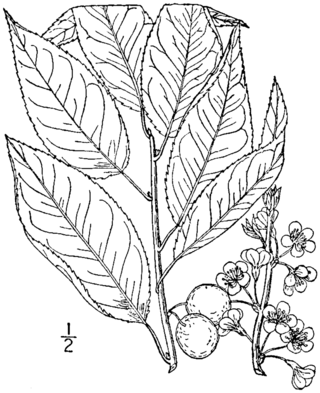
Prunus alleghaniensis, the Allegheny plum, is a species of New World plum, native to the Appalachian Mountains.

Prunus angustifolia, known commonly as Chickasaw plum, Cherokee plum, Florida sand plum, sandhill plum, or sand plum, is a North American species of plum-bearing tree. It was originally cultivated by Native Americans before the arrival of Europeans. The species' name angustifolia refers to its narrow leaves. It became the official state fruit of Kansas in 2022.
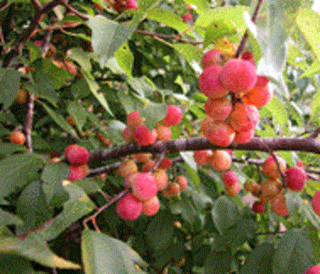
Prunus rivularis, known variously by the common names creek plum, hog plum, or wild-goose plum is a thicket-forming shrub. It prefers calcareous clay soil or limestone-based woodland soils. This deciduous plant belongs to the rose family, Rosaceae, and is found mainly in the central United States. It is a shrub consisting of slender stems with umbel clusters of white blossoms. The fruit is a drupe that resembles a large berry; though it has a bitter taste, it serves as a source of food for birds and other wildlife. "Prunus" is Latin for plum, whereas "rivularis" means being near a stream.
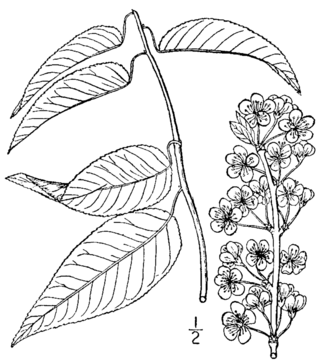
Prunus hortulana, called the hortulan plum and wild goose plum, is a fruit shrub in the rose family found in the central United States in: Arkansas, Iowa, Illinois, Indiana, Kansas, Kentucky, Massachusetts, Maryland, Missouri, Nebraska, Ohio, Oklahoma, Tennessee, Texas, Virginia, West Virginia. Populations east of the Appalachians probably represent naturalizations.
Prunus havardii, called Havard's wild almond or Havard's plum, is a rare North American species of shrub tree native to western Texas in the United States and to northern Chihuahua across the Río Grande in Mexico. It is in the genus Prunus in the rose family, Rosaceae.

Prunus texana, called peachbush, Texas almond cherry, Texas peachbush, sand plum, peach bush, and wild peach is native to central and western Texas. Although it looks like peach, it actually belongs to Prunus sect. Prunocerasus together with other North American plum species.

Prunus umbellata, called flatwoods plum, hog plum and sloe plum, is a plum species native to the United States from Virginia, south to Florida, and west to Texas.

Prunus minutiflora, called the Texas almond, is a shrub native to Texas and northern Mexico.
Prunus murrayana, called the Murray's plum, is a critically endangered shrub native to Texas. It is found in the Edwards Plateau and the trans-Pecos regions of the state.



















